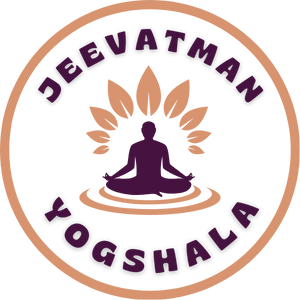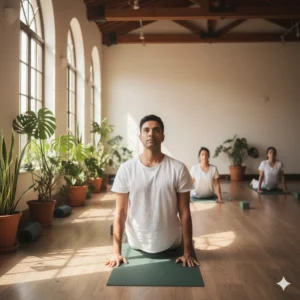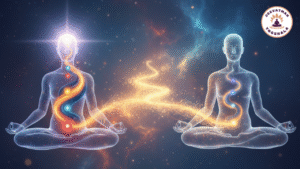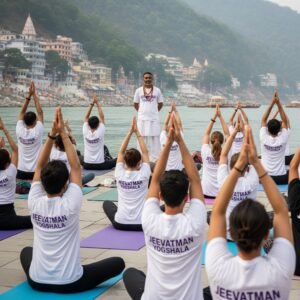Introduction Surya Namaskar, or Sun Salutation is one of the most well-known and respected yoga practices on the planet. It’s a series of 12 yoga postures or asanas that will stretch, strengthen and invigorate the whole body. Apart from its physical benefits, Surya Namaskar also enhances your mind and spirit. It is a flowing sequence of moves and breath work, done at sunrise, facing the sun, and it demonstrates appreciation for the sun’s vital, life-sustaining energy.
What is Surya Namaskar?
Surya means sun, and Namaskar is salutation or greeting. Surya Namaskar is a ritual in which you offer salutations to the sun in the form of a sequence of 12 yoga poses. In the West, we refer to this as “Sun Salutation” because this sequence energizes the physical and energic body, and invigorates the mind – much like how the rays of the sun energize the earth.
These 12 asanas are performed in a sequence and when performed properly, Surya Namaskar can act as a full body workout. It enhances flexibility, muscle tone and cardiovascular health.
But it is so much more than a physical practice. A sun salutation is also spiritual—it acknowledges a different facet of the sun’s energy with every pose. Because of this, Surya Namaskar practitioners tend to feel more stable, present and spiritually connected after practicing the series.
The Meaning of Surya Namaskar
As its very name suggests, Surya Namaskar is a tech-driven way of enlivening the solar power which is life sustainer. In multiple spiritual beliefs, the Sun represents the source of all power, energy and divine life force. So Surya Namaskar is also not merely physical exercise but expressing gratitude to the sun’s life giving force.
The 12 poses of Surya Namaskar are performed in succession, with each pose counteracting the preceding one, to form a consistent, steady cycle harmonizing body and mind. Practice is both an active and passive method, done especially through exertion and mindful breathing to open our awareness and increase focus.
Surya Namaskar – Why Do We Perform This Ancient Galactico-Core?
The roots of Surya Namaskar are firmly grounded in historic Indian yoga traditions. The sun was hailed as a divine power, even in prehistoric times, and what’s more, even in the Hindu religion, there are references where the sun is revered as the source of power and energy.There are many cultures all over the world which have been worshipping the sun for the past thousands of years. In yoga and related traditions the sun is also regarded as a symbol of the soul, the inner light that directs our lives.
Surya Namaskar The Surya Namaskar is believed to have been created by ancient yogis to tap into the sun’s energy, improve strength, and stimulate the mind. These twelve asanas relate to up and down movements of the sun and help the practitioner to unlock and realign body, mind and spirit to these solar energies.
Surya Namaskar is also said to enable to experiencers to connect with their own solar energy, bringing them increased vitality, mental clarity, emotional balance and health. It is relies on the principle of moving meditation, in which the body allows the passage of spiritual energy, while the mind is kept clear and present.
The Various Benefits Of Surya Namaskar
A Full body workout Surya namaskar is one of the most complete practice in hatha yoga that includes a rejuvenating physical, mental and spiritual process. You can enhance your health, mental clarity, and emotional balance by doing the 12 poses regularly. Now, let us analyse what are the direct benefits that Surya Namaskar gives.
Physical Benefits
Improves Flexibility
Surya Namaskar comprises forward and backward bends, flexing and stretching of the spine and the limbs, and the spinal twist which affects the muscles of legs, back, and the spinal column. With greater flexibility it can do wonders for your posture, and also prevent injury in any other sport or activity.
Strengthens the Muscles
The postures in Surya Namaskar work and tone and strengten almost every muscle in the body. It’s great for muscle tone in the arms, legs, back and core. The technique is designed to develop muscles and also combat fighting endurance and stamina.
Increases Blood Circulation
Surya namaskar gets the blood rushing and helps send it to all the corners of your body. As the body flows, blood is massaged to various areas of the body, helping with oxygenation and reenergising the body by way of a lymph cleanse.
Enhances Digestion
The asanas in Surya Namaskar compress and stretch the abdominal organs, enhancing digestion. This is very beneficial for those who struggle with constipation, bloating and other digestive issues.
Boosts Energy Levels
Surya Namaskar is frequently performed in the morning, facing the rising sun. This time of year along with the sun’s energy give a boost to our vitality and energy. The sequence of movements, along with deep breaths, increase the flow of oxygen to the brain, which makes you feel more alert and awake.
Improves Posture
Surya Namaskar strengthens the muscles of the back, core, and legs – leading to better posture. It helps align the spine and prevents and helps with lower back pain when you sit for a long time.
Detoxifies the Body
The flowing nature of the poses is especially effective in promoting the activity of the lymphatic system, as its combo of active movement of postures and passive hanging serves to flush out toxins. This will help cleanse the body and promote health.
Mental Benefits
Reduces Stress
The deep breathing and the relaxed movements that Surya Namaskar offers can help to activate the part of your nervous system that will help your body calm down. That results in lowered stress and a feeling of peace.
Improves Focus and Concentration
Surya Namaskar needs to be accompanied by breathing in the coordinated rhythm. This mindfulness exercise helps improve your power of concentration -your power to focus, to fix your attention, to concentrate on what you are doing. Great mental exercise, I’d say.
Enhances Mood
It is a great mood enhancer: Practising Surya Namaskar promotes the release of endorphins, also known as “the happy hormones” due to their ability to make one feel great. It may make you feel happier, more confident and in better spirits with practice.
Calms the Mind
As you do Surya Namaskar you should concentrate on your breath and remain in the moment. That quiets mental chatter and imparts a sense of inner peace—a useful tool for coping with anxiety or depression.
Spiritual Benefits
Awakens Spiritual Energy
Surya Namaskar activates the solar plexus, which is known as the “seat of personal power” in yoga. Activating this energy point can give you a boost of inner power and self-assuredness.
Promotes Mind-Body Connection
Surya Namaskar is synchronized with the breath, thereby improving the relationship between the body and the mind. This alignment creates a deeper sense of what your body is feeling, and puts you more closely in touch with your physical and emotional feelings.
Cultivates Gratitude
Practising Surya Namaskar in the morning, facing east in the direction of the sun fills us with gratitude for the life-nourishing energy that the sun showers upon us. It gives practitioners a way to contemplate their relationship to nature and the universe.
Yoga You Can also Use Surya Namaskar as the Warm-Up Exercise
Surya Namaskar can be practiced as warming up before more advanced yoga practices. The rhythmic and flowing sequences aid in releasing the tight muscles and joints, improving circulation, and creating a harmonious flow of energy within the body. The sequence initialises the body for fuller stretches and more advanced asanas.
If practised in the morning, Surya Namaskar can aid in waking up the body and getting rid of morning creakiness. It can also be used to promote mental clarity and focus — to create “space” for a more powerful experience on the mat or cushion during a yoga or meditation practice.
Wondering Why You Need To Warm Up Before Surya Namaskar?
It is important to warm up before doing any kind of exercise in order to protect yourself and get your muscles moving for harder exercises. A warm-up helps to:
- Loosen tight muscles and joints
- Increase circulation
- Engage the breath-body connection
- Prevent injury
It is essential to ease the body into the asanamen132 (including su 133 ry_Namaskar) through a gentle, step by step approach, that warms the body through a progressive series of postures that stretch the whole body.
Suggested Warm-Up Exercises
Before beginning Surya Namaskar, dedicate 5-7 minutes to the following warm-up exercises to prepare your muscles and joints:
Neck Rolls
Slowly roll your neck in a circular motion in both directions. This will help relieve pressure from your neck and shoulder.
Shoulder Rolls
2.ROLL BOTH SHOULDERS FORWARD AND BACKWARD TO LOOSEN THE SHOULDER JOINTS AND BETTER YOUR POSTURE.
Arm Circles
Stretch your arms and then rotate them in small and large circles. That builds your shoulders and gets your arms warm.
Side Bends
Step your feet together and lift your arms up. Then gently sway to the left and right to stretch the sides and your spine.
Hip Circles
Put your hands on your waist and circle your hips lazily. This will allow you to relax your low back and hip region.
Knee Lifts
Raise your knees in the air, and keep your core tight. This will elevate your heartrate and will fire the lower body.
Ankle Rolls
One at a time, turn each ankle around to get your feet and legs ready for balance and movement.
The 12 Asanas of Surya Namaskar
There are 12 poses in Surya Namaskar and each pose has specific breathing patterns. Here’s how the poses break down:
Pranamasana (The prayer pose) – Stand straight with feet together and place your palms together in front of your chest.
Breathing: Normal.
Benefits Calms body and mind; improves posture; prepares you for the sequence.
Hasta Uttanasana (Raised Arms Pose) -Inhale and raise your arms overhead and arch the back a little.
Breathing: Inhale.
Benefits: Stretches the chest and belly, expands lung capacity.
Padahastasana (Standing Forward Bend) – Exhale and lean forward from the hips until your palms touch the floor.
Breathing: Exhale.
Benefits: Stretches the hamstrings; aids digestion.
Ashwa Sanchalanasana (Equestrian Pose) – Inhale and move your right leg back, placing it back, while bending the left knee, and keeping the hands on the floor.
Breathing: Inhale.
Benefits: Stretches and opens the legs, hips and spine; strengthens the lower body.
Dandasana( Plank Pose) Exhale and step back, coming in to a plank, arms and body forming a straight line.
Breathing: Exhale.
Benefits: Tones the arms, shoulders and core.
Ashtanga Namaskara (Eight-Limbed Pose) – Lower your knees, chest, and chin down while the hips are lifted slightly.
Breathing: Hold your breath.
Benefits: Tones the chest and arms, increases flexibility in the spine.
As you exhale, slide forward to fold your chest into a soft back bend (Bhujangasana, Cobra).
Breathing: Inhale.
Benefits: Strengthens the spine, broadens the chest and increases circulation.
Adho Mukha Svanasana (Downward-Facing Dog) – Breathe out and raise the hips high and back, an upside down V.
Breathing: Exhale.
Benefits: Stretches the back, hamstrings, and calves.
Ashwa Sanchalanasana (Equestrian Pose, other leg) – Inhale and bring your left leg forward while stretching the right leg backwards.
Breathing: Inhale.
Pros: Great for balance and lower body strength.
Padahastasana (Foothand Forward Bend) – Exhale and step the right foot forward.
Breathing: Exhale.
Benefits: Also like step 3, this opens the hips, and also has a soothing effect on the nervous system.
Hasta Uttanasana (Raised Arms Pose) – Inhale as you raise your arms up overhead.
Breathing: Inhale.
Benefits: Stimulates the body and opens the chest.
Pranamasana (Prayer Pose) – Exhale and come back to standing position by joining__ the palms in front of your chest.
Breathing: Exhale.
Benefits: Stills the body and the mind, and ends the sequence.
Surya Namaskar Variations
| Style | Pace | Difficulty | Special Focus |
|---|---|---|---|
| Hatha Yoga | Slow | Beginner | Tradition, mindfulness |
| Ashtanga A & B | Fast | Advanced | Strength, flow, discipline |
| Vinyasa Flow | Variable | Intermediate+ | Creativity, breath-movement |
| Iyengar | Slow | All levels | Alignment, therapy |
| Bihar School | Gentle | All levels | Mantras, chakras, meditation |
| Power Yoga | Fast | Advanced | Fitness, weight loss |
| Chair Yoga | Gentle | Beginner | Accessibility |
| Kids’ Yoga | Playful | Easy | Engagement, fun learning |
There are variations of Surya Namaskar with schools and in different styles of yoga. Here are some popular ones:
HAHA YOGA SURYA NAMASKAR, traditional and gentle for beginners.
Ashtanga Surya Namaskar A & B: Energetic, targeted strength and endurance.
VINYASA FLOW: A dynamic, flowing practice moving one breath at a time.
Iyengar: Emphasis on alignment and precision.
School of Bihar Yoga: Focuses on breath and mantra chanting.
Power Yoga: A faster-paced, fitness-based approach.
Chair Yoga: A modified form for people who are extremely weak, frail or otherwise unable to practice standing poses.
Kids’ Yoga: A fun and easier version meant for children.
Conclusion
Surya Namaskar can be a total therapy both physically and mentally for the entire body. It offers flexibility and builds strength, sharpens concentration and diminishes stress, and is equally useful in reminding you of God’s presence. Regardless of whether you execute it as a warm up before more challenging yoga session or as an independent practice, Surya Namaskar is a perfect way of beginning your day full of gratitude and energy. And when you make time for it each day, you will feel more balanced, energized combined focused.








